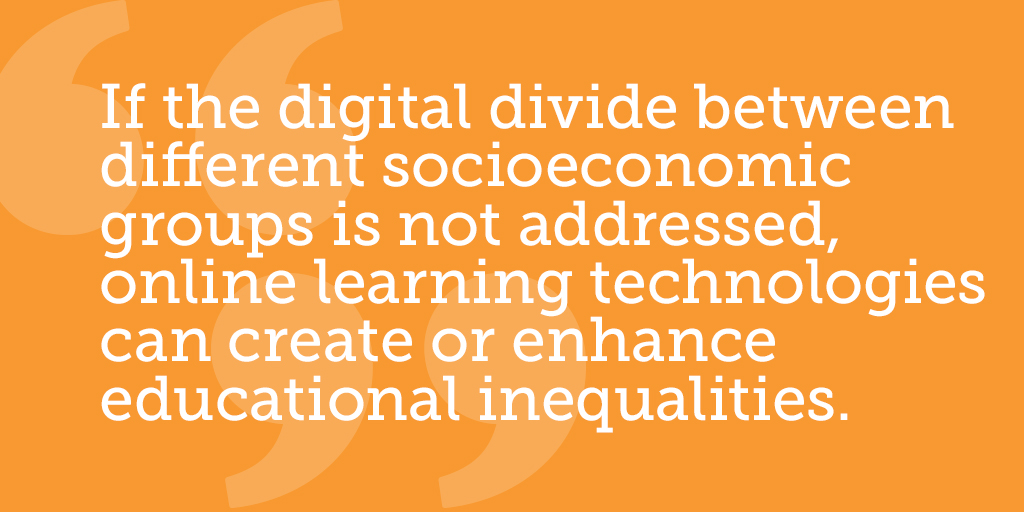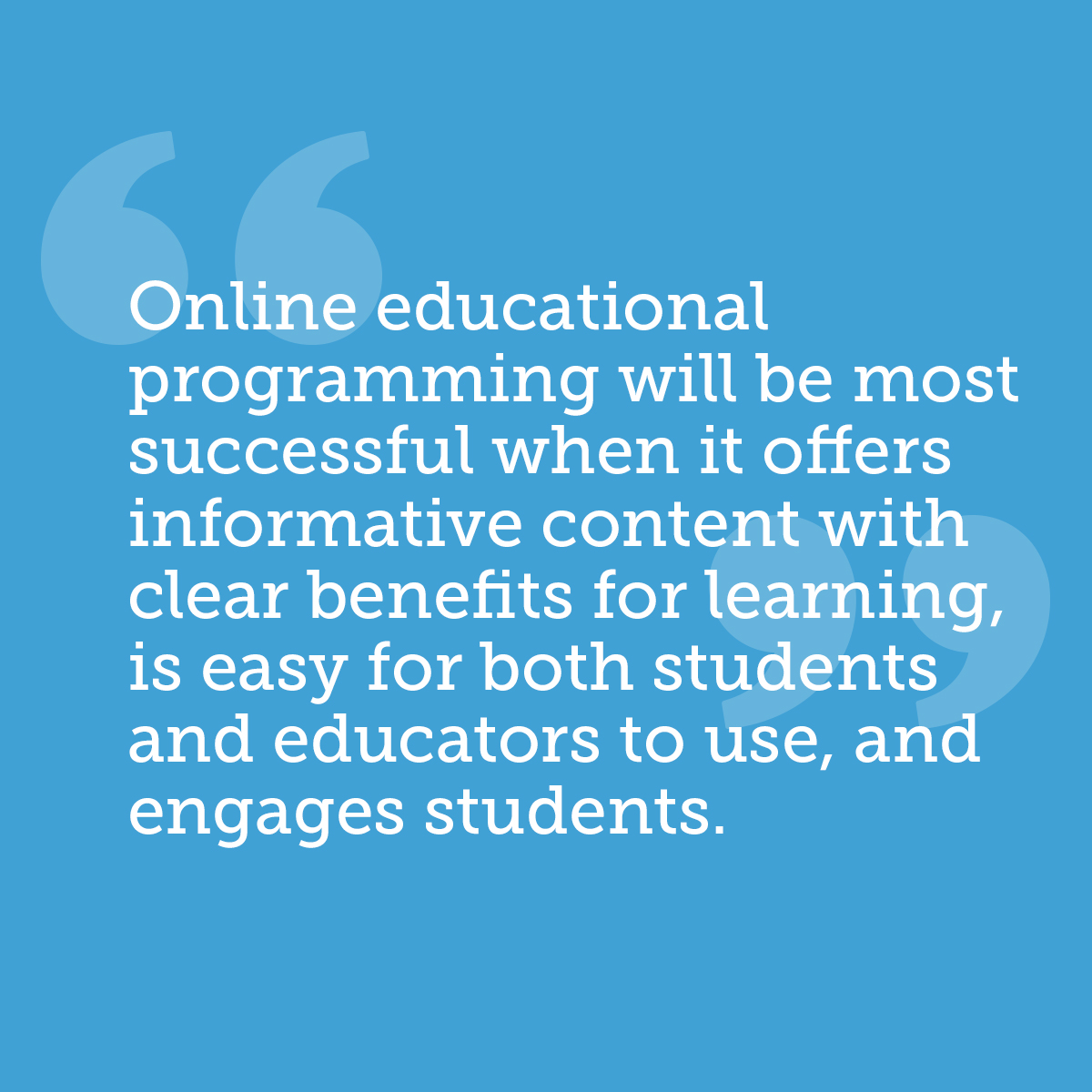
Technology has opened up a world of opportunities for online learning.[i] Many students now keep track of their coursework, read and watch educational content, and submit assignments through their schools’ online learning management systems (LMS). In addition, students have access to a broader range of classes and content areas through virtual classrooms and online distance learning. Outside the school setting, children informally learn from educational video games and online content, while people of all ages master new subjects in free massive open online courses (MOOCs).
Some forms of online learning translate the traditional class structure into the digital realm, while others open up new methods for communication among educators and students. In synchronous learning, an educator and their students gather online at the same time in a virtual classroom. Asynchronous learning does not require that students and instructors be online at the same time, opening up the possibility of self-paced and personalized learning tailored to individual students. Blended learning combines face-to-face instruction in a physical classroom with online learning activities.
According to the International Association for K-12 Online Learning, when evaluating online and virtual education programs, researchers should consider: content, instructional design, student assessment, technology, and course evaluation and support.[ii] However, like the technologies that enable online learning, research on the topic is still in a work in progress, particularly when it comes to evaluating the outcomes of online learning.
The section below highlights key findings from the emerging research on online learning.
 Today’s students are often labeled as digital natives because they grew up with technology integrated into their daily lives, and as a result, many people assume that it is easy for them to adopt online learning technologies. However, not all students are equally comfortable with digital technology or have reliable access to it,[iii] and there are differences in how technology is integrated, both in schools and in homes, between high- and low-socioeconomic status households.[iv] Not only may students in low-socioeconomic status schools lack some of the skills required to adequately utilize digital tools in their learning, these students also tend to receive fewer opportunities to technology beyond drills and memorization for higher-order thinking skills.[v] If the digital divide between different socioeconomic groups is not addressed, online learning technologies can create, or enhance existing, educational inequalities.[iv]
Today’s students are often labeled as digital natives because they grew up with technology integrated into their daily lives, and as a result, many people assume that it is easy for them to adopt online learning technologies. However, not all students are equally comfortable with digital technology or have reliable access to it,[iii] and there are differences in how technology is integrated, both in schools and in homes, between high- and low-socioeconomic status households.[iv] Not only may students in low-socioeconomic status schools lack some of the skills required to adequately utilize digital tools in their learning, these students also tend to receive fewer opportunities to technology beyond drills and memorization for higher-order thinking skills.[v] If the digital divide between different socioeconomic groups is not addressed, online learning technologies can create, or enhance existing, educational inequalities.[iv]
According to the prominent technology acceptance model (TAM), there are two key factors that determine whether someone will adopt a new technology: perceived ease of use and perceived usefulness to one’s work.[vi] Research shows that these are two of the most important factors determining whether both students and educators accept and use online learning tools.[vii] Another important factor for students is whether they find a program enjoyable and interesting (perceived playfulness).[viii] This research suggests that online educational programming will be most successful when it offers informative content with clear benefits for learning, is easy for both students and educators to use, and engages students. Some studies also suggest that social influence and peer norms can play a role in whether people are willing to adopt online learning technologies.[ix]
 While social networking platforms are popular among students, their potential as an educational tool is not yet clear.
While social networking platforms are popular among students, their potential as an educational tool is not yet clear.Given their popularity among teenagers and young adults, social networking applications like Facebook may have potential as an educational tool. However, most young people use Facebook primarily for entertainment and to communicate with friends, not for educational purposes.[x] Some scholars have proposed building on the social aspect of Facebook and using it as a LMS that facilitates communication between educators and students.[x] But research on the use of social networking platforms as learning environments is limited.[xi] Setting aside its potential educational uses, there is concern about whether social networking can negatively affect academic performance by serving as a distraction from studying, or encouraging students to multitask.[xii]
Explore Technology & Learning on the Visualization.
Citations
[i] Evergreen Education Group (2015) Keeping Pace with K12 Digital Learning: An Annual Review of Policy and Practice.
[ii] iNACOL (2011). iNACOL National Standards for Quality Online Courses.
[iii] The ‘digital natives’ debate: A critical review of the evidence [Review] Bennett S, Maton K, Kervin L,BRIT J EDUC TECHNOL (2008).
[iv] Rideout, V. J. & Katz, V.S. (2016). Opportunity for all? Technology and learning in lower-income families. A report of the Families and Media Project. New York: The Joan Ganz Cooney Center at Sesame Workshop.
[v] Reinhart, J., Earl, T., & Toriskie, J. (2011) K-12 Teachers: Technology Use and the Second Level Digital Divide. Journal of Instructional Psychology, 38(3), 181-193.
[vi] Davis, F. D. (1989). Perceived usefulness, perceived ease of use, and user acceptance of information technology. MIS quarterly, 319340.
[vii] An empirical study of instructor adoption of web-based learning systems [Article] Wang WT, Wang CC, COMPUT EDUC (2009).
Understanding pre-service teachers’ computer attitudes: applying and extending the technology acceptance model [Article] Teo T, Lee CB, Chai CS, J COMPUT ASSIST LEAR (2008).
De Smet, C., Bourgonjon, J., De Wever, B., Schellens, T., & Valcke, M. (2012). Researching instructional use and the technology acceptation of learning management systems by secondary school teachers. Computers & Education, 58(2), 688696.
Predicting user acceptance of collaborative technologies: An extension of the technology acceptance model for e-learning [Article] Cheung R, Vogel D,COMPUT EDUC (2013). Investigating e-learning system usage outcomes in the university context [Article] Islam AKMN, COMPUT EDUC (2013).
[viii] The acceptance and use of computer based assessment [Article] Terzis V, Economides AA,COMPUT EDUC (2011).
Explaining and predicting users’ continuance intention toward e-learning: An extension of the expectation- confirmation… [Article] Lee MC,COMPUT EDUC (2010).
[v] An empirical study of instructor adoption of web-based learning systems [Article] Wang WT, Wang CC, COMPUT EDUC (2009).
Understanding pre-service teachers’ computer attitudes: applying and extending the technology acceptance model [Article] Teo T, Lee CB, Chai CS, J COMPUT ASSIST LEAR (2008).
De Smet, C., Bourgonjon, J., De Wever, B., Schellens, T., & Valcke, M. (2012). Researching instructional use and the technology acceptation of learning management systems by secondary school teachers. Computers & Education, 58(2), 688696.
[ix] Cheung, R. & Vogel, D. (2013). Predicting user acceptance of collaborative technologies: An extension of the technology acceptance model for e-learning. Computers & Education, 63: 160–175.
Wang, Y., Wu, M, Wang, H. (2008). Investigating the determinants and age and gender differences in the acceptance of mobile learning. British Journal of Educational Technology, 40(1): 92–118.
Karaali, D., Gumussoy, C., & Calisir, F. (2011). Factors affecting the intention to use a web-based learning system among blue-collar workers in the automotive industry. Computers in Human Behavior, 27(1): 343–354.
[x] Mao, J. (2014). Social media for learning: A mixed methods study on high school students’ technology affordances and perspectives. Computers in Human Behavior, 33: 213-223. Hew, K. F. (2011). Students’ and teachers’ use of Facebook. Computers in Human Behavior, 27(2): 662-676.
[xi] Manca, S., & Ranieri, M. (2013). Is it a tool suitable for learning? A critical review of the literature on Facebook as a technology‐enhanced learning environment. Journal of Computer Assisted Learning, 29(6): 487-504.
[xii] Kirschner, P. A., & Karpinski, A. C. (2010). Facebook and academic performance. Computers in human behavior, 26(6): 1237-1245.
[vi] Predicting user acceptance of collaborative technologies: An extension of the technology acceptance model for e-learning [Article] Cheung R, Vogel D,COMPUT EDUC (2013).
Investigating e-learning system usage outcomes in the university context[Article] Islam AKMN, COMPUT EDUC (2013).